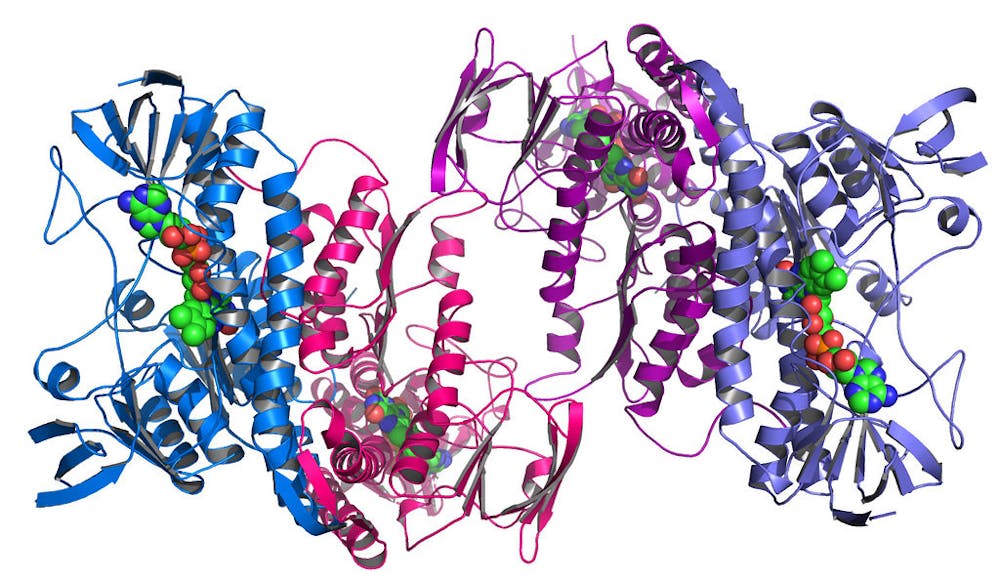Stephen Fried, an assistant professor in the Department of Chemistry, and his lab recently identified a cohort of proteins in Escherichia coli (E. coli) that cannot refold even in the presence of molecular chaperones, which recognize and undo folding mistakes. Their results, which may have applications in studying aging, were published in the Proceedings of the National Academy of Sciences.
In neurodegenerative diseases such as Alzheimer’s and Parkinson’s, abnormal protein aggregation leads to the loss of healthy neurons. Identifying which proteins are unable to refold to their original state and unraveling the reasons behind it can shed light on potential new treatment targets for these diseases.
Translation is the process where cellular organelles known as ribosomes synthesize proteins by assembling amino acids. As proteins are assembled, they often have to be folded into the proper conformation.
In an interview with the News-Letter, Fried explained how proteins fold as they are created, comparing the translation process to how cars are assembled.
“Instead of throwing all parts of a car and hoping [for] them to just magically assemble, we have to add each part in a certain order. The ribosomes fold proteins the same way. It is one amino acid at a time and folding simultaneously,” he said.
According to Fried, structurally simple proteins can restructure themselves spontaneously if misfolded. However, more structurally complicated proteins may require chaperones, or structures that can recognize and correct protein mistakes, for refolding. In a way, these chaperones give proteins a second chance in the event that they are damaged.
However, if a protein is folded at the same time it is assembled, there might not be a biological reason for the protein to refold in response to damage, making it less likely to be fixed.
The study focused on proteins in E. coli. In order to investigate protein refolding, the researchers first added denaturants, or substances to cause the proteins to chemically unfold. Then, they removed the denaturants and waited for the proteins to refold either with or without molecular chaperones.
Fried and his team identified a group of proteins in E. coli that could not refold to their native structures even in the presence of molecular chaperones. They explained that these proteins fold co-translationally.
According to Fried, proteins that can only fold correctly when ribosomes assemble them for the first time can be more vulnerable to mistakes in protein synthesis in neurodegenerative diseases associated with aging. Fried’s research may be able to identify ways to help these proteins fold, even if our bodies do not naturally offer molecular chaperones for them.
“Proteins that can refold are ageless. Those that can’t refold are more at risk of being problematic,” Fried said.
In their study, Fried and his lab used limited proteolysis-mass spectrometry. Unlike other approaches, such as antibody-based assays that only study one type of protein at a time, mass spectrometry can examine a full scope of proteins in a sample and identify their structural changes simultaneously. Beyond studying protein folding, mass spectrometry is also applied in NASA’s sample analysis on Mars and explosives detection at airport security.
Beyond E. coli, Fried’s lab is interested in protein folding in other types of bacteria and fungi. Through a program called FiGURE (first-generation undergraduate research experience), a few Hopkins undergraduates have actively engaged with Fried's lab. The students introduced the lab to meaningful research targets such as thermophiles and mold.
In addition, Fried noted his team is collaborating with Hopkins neuroscientist Michela Gallagher to investigate protein folding in neurodegenerative diseases. With the same study method, the researchers are currently studying the brain tissues of rats with cognitive decline to identify proteins that are structurally altered due to cognitive impairment. These proteins share traits with the cohort of proteins that can’t refold. They hope these proteins could be new targets for drugs to treat neurodegenerative diseases.

















